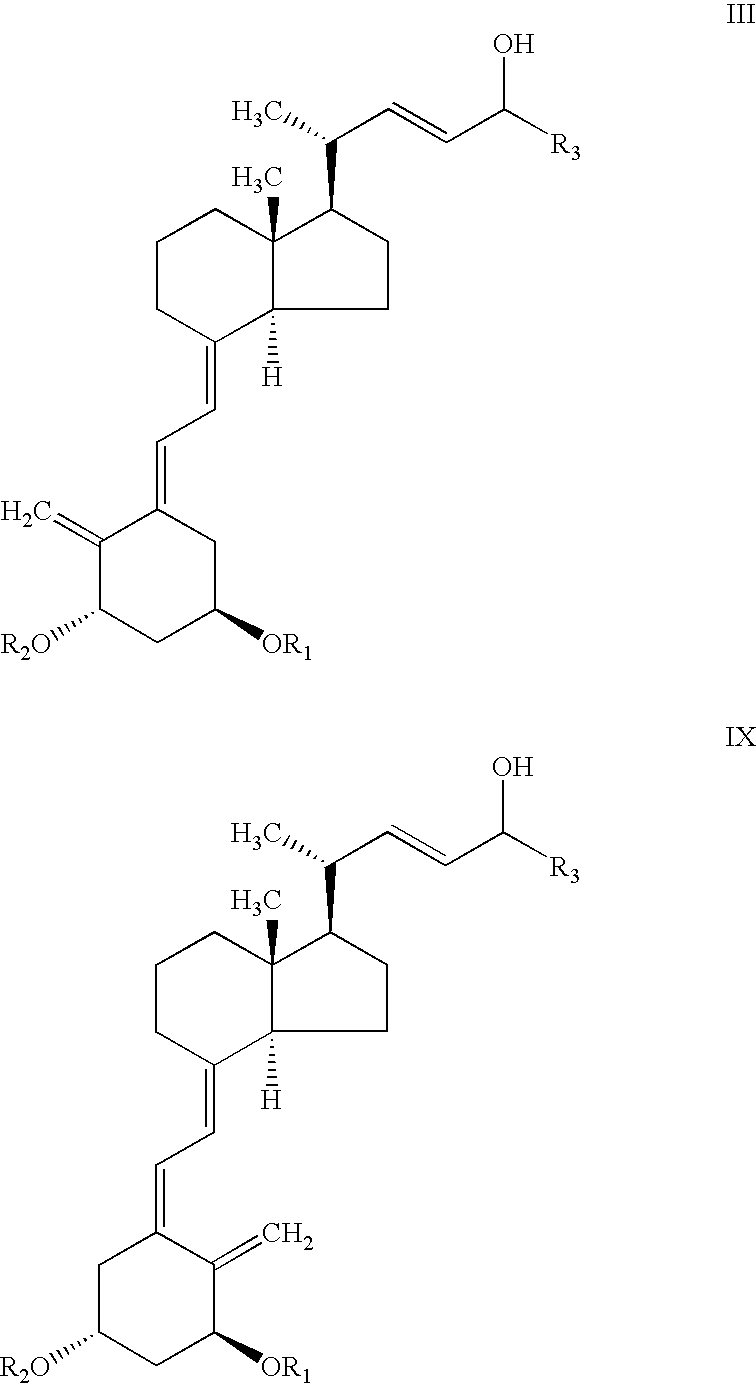Selective enzymatic esterification and solvolysis of epimeric vitamin D analog and separation of the epimers
a technology of enzymology and esterification, applied in the field of selective enzymology esterification and solvolysis of epimeric vitamin d analog and separation of epimers, can solve the problems of chromatographic separation, unfavorable process of scale up, and inability to efficiently separate, so as to achieve the effect of reducing the number of chromatographic separations
- Summary
- Abstract
- Description
- Claims
- Application Information
AI Technical Summary
Problems solved by technology
Method used
Image
Examples
example 1
Selective Enzymatic Esterification
[0064]To a stirred solution of C-24 epimeric alcohol mixture of structure III, R1=R2=tert butyldimethylsilyl and R3=cyclopropyl, (20 gr, 31.2 mmol) and vinyl acetate (5.8 ml, 62.4 mmol) in hexane (60 ml) was added 0.56 gr Alcaligenes sp. Lipase. The mixture was stirred for 3 hours at 25+3° C. after which time the HPLC analysis showed essentially complete conversion of epimer C-24 (R) to the acetate. The remaining nonesterified C-24 (S) alcohol was >99% diastereomeric excess (by HPLC). The solution was filtered and concentrated to dryness. The residue was chromatographed on pre-treated silica gel with 5% ethyl acetate in hexane then with ethyl acetate to give C-24 acetate compound IV (11 gr) and C-24 alcohol compound V (7.4 gr).
The purity profile of the product was as follows.
[0065]
Purity profileInstrument and methodCompoundIVVVIIIMerck-HitachiIV93.10.2—Model: L-6200A intelligentV0.589.01.6pump. Mobile phase : 0.5%amyl alcohol in hexane
example 2
Selective Enzymatic Esterification
[0066]0.5 g of Alcaligenes sp. lipase was immobilized onto 4 g Eupergit C (Rohm, Germany) according to a known procedure recommended by the supplier. To a round bottom flask containing 0.3 g (0.47 mmol) C-24 epimeric alcohol mixture III, R1=R2=tert-butyldimethylsilyl and R3=cyclopropyl, (65:35 isomer ratio), 0.43 ml (4.7 mmol) vinyl acetate and 3.57 ml hexane, 400 mg of immobilized enzyme was added. The mixture was stirred at 35° C. for 4 hours, after which time the HPLC analysis showed the presence of 30% compound IV, 35% compound VIII and 35% unreacted compound of structure V.
example 3
Selective Enzymatic Esterification
[0067]To a vial containing 100 mg (0.16 mmol) of mixed C-24 epimers of C-24 alcohol of structure III, with R1=R2=tert-butyldimethylsilyl and R3=cyclopropyl, (65:35 isomer ratio), 0.044 ml (0.47 mmol) vinyl acetate and 1.5 ml diisopropyl ether, 10 mg of Alcaligenes sp. lipase was added. The mixture was stirred at room temperature for 2 hours after which time the HPLC analysis showed the presence of 65% compound IV and 35% compound of structure V.
PUM
| Property | Measurement | Unit |
|---|---|---|
| Temperature | aaaaa | aaaaa |
| Temperature | aaaaa | aaaaa |
| Fraction | aaaaa | aaaaa |
Abstract
Description
Claims
Application Information
 Login to View More
Login to View More - R&D
- Intellectual Property
- Life Sciences
- Materials
- Tech Scout
- Unparalleled Data Quality
- Higher Quality Content
- 60% Fewer Hallucinations
Browse by: Latest US Patents, China's latest patents, Technical Efficacy Thesaurus, Application Domain, Technology Topic, Popular Technical Reports.
© 2025 PatSnap. All rights reserved.Legal|Privacy policy|Modern Slavery Act Transparency Statement|Sitemap|About US| Contact US: help@patsnap.com



